Leaves can be deformed as a result of a shortage of substances, which is easily corrected by feeding. But sometimes the cause is a disease or virus: in this case it is often too late to save the plant, and you need to remove it so as not to harm the rest of the crops. We analyze the main reasons why cucumbers twist leaves inward and how to deal with it.
Content
Causes of deformation
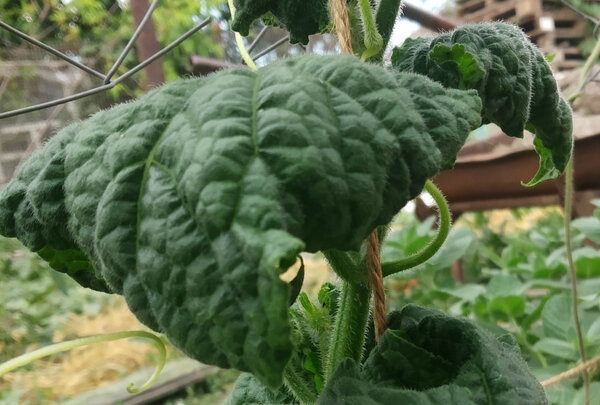
Even leaving by all the rules does not guarantee that the crops will grow flawless. Often external factors, infections and pests interfere with the growth of cucumbers. But the human factor should not be discounted. Improper watering, lack of complementary foods, or lack of sunlight also cause problems. The leaves are twisted around seedlings on the windowsill, greenhouse crops and cucumbers in the ground. All reasons can be divided into four categories:
- weather;
- pests;
- infections and viruses;
- mistakes in leaving.
It is important to determine the cause correctly, in order to eliminate it in time and not harm the landings. Evaluate the condition of the plants in the complex: folding can indicate serious problems if combined with a change in color, the appearance of spots and other symptoms.
Wrong watering
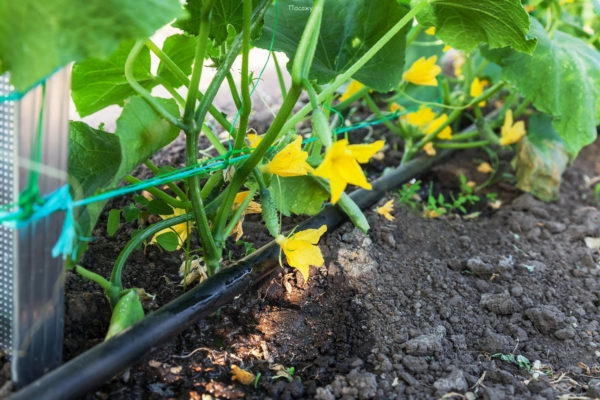
Cucumbers are moisture-loving plants. For good growth, they need to get enough water, and the humidity in the room, if you grow vegetables in a greenhouse, should be at the level of 70-80%. In hot, dry weather, it’s worth watering cucumbers regularly, even every day. Dryness and lack of moisture - the most common, but harmless reason for curling leaves. Solving the problem is simple: you need to do regular watering and monitor the humidity of the air and soil.
Under normal conditions, watering cucumbers is not more than once every 4 days. Water should be at room temperature, the approximate consumption is 4-5 liters per square plantings. After the formation of the ovaries, watering is more frequent, now the soil needs to be moistened 3-4 times a week and spend twice as much water. The same goes for the harvest season. Be sure to loosen the ground before watering: so the water will have more access to the roots. Curl of leaves in cucumbers in a greenhouse often appears due to a lack of moisture not in the soil, but in the air. In order to raise the level to normal, spray plants and walls of the room with clean water from a spray bottle. It is better to do this in the morning, so in a day the moisture will have time to evaporate.
At the same time, transfusing plants is also harmful: the abundance of water causes the development of fungal infections and reduces immunity. Stagnation of moisture also leads to curling of the leaves and loss of their shape. If you have not noticed other signs of infection or pests, then most likely the reason is excessive watering. Stop wetting the plants until the soil dries, and then go back to normal. The abundance of moisture leads to waterlogging of the soil, the formation of a crust and salting.
Mineral deficiency
Another reason why seedlings or cucumbers twist leaves in or out is the lack of the necessary elements in the soil. In this case, twisting is often accompanied by blanching of the sheet. Nitrogen deficiency leads to color loss, which is especially important in the early stages of growth. Nitrogen starvation is accompanied by extension of the central vein and a lag in the development of the main part of the leaf plate.Ammonium nitrate, urea or nitrogen-based fertilizers will help to cope with the problem. Sometimes the edges of the leaves turn yellow or light spots appear.
Twisting also causes potassium deficiency. In this case, the leaves curl down. It can be replenished with the help of potassium salt or wood ash. Ashes are diluted in a ratio of 1 to 6, insisted for 10 hours and diluted with clean water to a weak consistency. An ash solution is poured under the root of the plant or, if cucumbers have already appeared, sprayed from a spray bottle.
Temperature changes
A warm, humid environment is comfortable for cucumbers, sudden changes in climate harm crops. Too cold weather causes the leaves to curl, and a sunburn leads to loss of color and wrinkling. Protect crops from direct sunlight with an awning or canopy from the film. Sunburn often causes wrinkling of leaves. Control the temperature outside, in case of a cold snap, cover the beds with flooring or mulch the soil. When growing seedlings at home, for example on a windowsill, try not to let the leaves come in contact with the glass. It quickly changes temperature: it instantly cools at night and heats up from the sun.
Pests
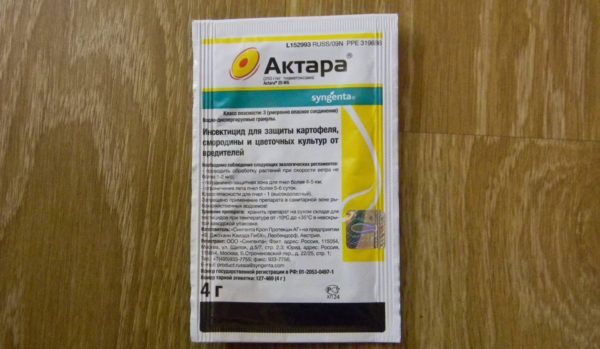
Plants shrink due to insects that are actively occupying fresh plantings. This problem can be seen with the naked eye: most pests concentrate on the back of the sheet and some cause active deformation and color changes. Cucumbers often attack spider mite or gourd aphids. Ticks can be recognized by a characteristic plaque similar to a web.
Pests should be disposed of as quickly as possible: they deprive cucumbers of nutrients, carry viruses, reduce immunity, and spoil the fruits. Insecticides help against aphids. You can use drugs such as Actara or Inta-Vir. Aktofit helps against mites.
Safe pest control methods are folk remedies. They can be used at any stage of growth, without fear of getting a toxic crop. Against pests, a good solution of ash with the addition of soap or garlic infusion. It is prepared from a kilogram of garlic, drenched in 6 liters of water. The mixture is insisted for 5-6 days, and then the crops are sprayed. You can also use ammonia: its smell repels pests, so that the tool is suitable for preventive measures.
Diseases and viruses
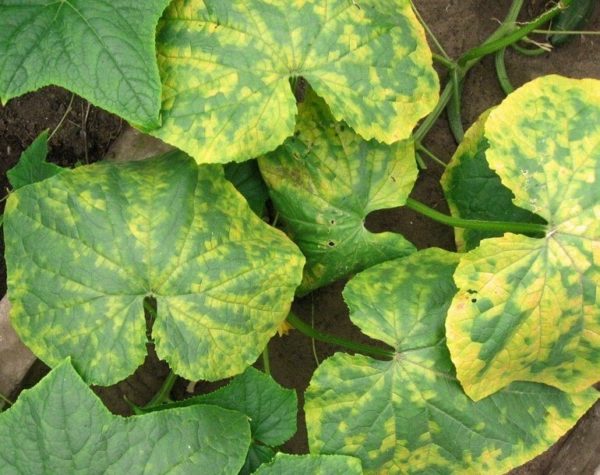
At high humidity, plants are often affected by fungal infections, which can cause deformation and curl of the leaf. To prevent the development of diseases, take care of crops, do not overfill them with water, maintain the temperature regime and pull out weeds on time - they, like aphids, often become carriers of infection. Common diseases of cucumbers:
- powdery mildew;
- rot of the roots;
- mosaic virus.
Powdery mildew appears in July. If you notice that the leaves are yellowed, cringed and wrinkled, then the reason may lie in a lack of nitrogen, as well as powdery mildew. This disease affects plants during sudden changes in temperature and weakened immunity. Also, too dense plantings can become the cause, the disease can migrate from bush to bush. The following recipe helps against mildew. Take 40 grams of copper chloroxide, dilute in a bucket of water. Spray planting at the rate of 100 ml per square plantings. An alternative is a 20% solution of colloidal sulfur, which is used to wipe leaves from all sides. Folk methods also help:
- Mullein infusion in a ratio of 1 to 3 is insisted for 3 days, and then diluted twice with clean water and sprayed crops.
- A liter of sour milk is diluted with a liter of water, filtered and used with a spray bottle once a week.
- 100 grams of baking soda are combined with 100 grams of soap chips, diluted in a bucket of warm water and sprayed with plants once a week.
The leaves are compressed, wrinkled and wrapped on the outside when the root system is in decline. This often appears due to root rot. It causes the appearance of yellowness on the green part of the plant, especially from below. The reason is often cold water for irrigation: it destroys the immune system and interferes with the absorption of moisture and minerals. The following scheme will help to cope with the disease:
- If the first symptoms are detected, water the plants with a solution of Previkur.
- After 5 days, pour cucumbers 20 ml of Fitolavin, diluted in a bucket of water.
- Sanitize soil against fungi.
- Restore the content of nutrients in the soil with fertilizers.
You can treat plants with Trichodermin or other biofungicides. Cucumbers in the greenhouse can be treated with fungicide Gamair. Two tablets of the substance are dissolved in a bucket of water and the rotted part of the plant is treated. The microbiological fungicide Glyokladin also works well, which helps with overdosing of beds with organic matter. You can avoid the appearance of root rot if you disinfect the soil with a solution of manganese before planting cucumbers in the soil. Compliance with the regime and conditions of irrigation helps, and in the greenhouse - regular ventilation.
The most unpleasant option is the infection of cucumbers with the virus. The most common mosaic is ordinary, which can be recognized by the characteristic ornament that forms on the sheet. Bushes affected by the virus need to be burned to protect other plants. The virus is insidious and can winter in soil, weeds or plant debris. Regularly update the soil, dig it up and remove the remnants of past crops before planting the following.
Ammonia burn
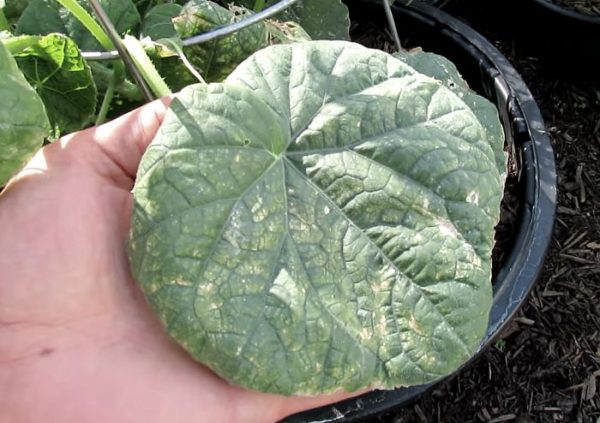
A burn can be obtained not only from the sun. Sometimes it happens that the leaves on the cucumbers dry and curl due to improper fertilizer. Excess nitrate or unripe manure can lead to chemical burns. To avoid such a problem, do not use fresh manure and observe the dosage. Since such top dressing is usually applied immediately to the soil, soil change will help against disaster. Remove the top layer as much as possible and replace it with a new one.
Pick
Cucumbers do not have a very strong root system, which can negatively react to a transplant. During movement, the plant may suffer or completely wither. If during transportation the roots were damaged, then the leaves may begin to curl, and the stem of the plant will sag. It is important to protect cucumbers from such risks from the very beginning. To do this, seedlings are planted in separate containers, such as peat pots, and transplanted carefully. During the dive, you can additionally use stimulants by dipping rhizomes in them before landing in the ground.
Landing pattern violation
Cucumbers should not be planted tightly. The optimal amount on open ground is 4 shrubs per square, in the greenhouse - 3. If the plants are too densely planted, the roots grow and are deficient in elements, taking them from each other. As a result, the leaves of cucumbers curl, dry, turn yellow. You can handle thinning out the beds. It is better to prevent such problems by pre-selecting a planting pattern and distributing the seedlings evenly.
Cucumber dressing
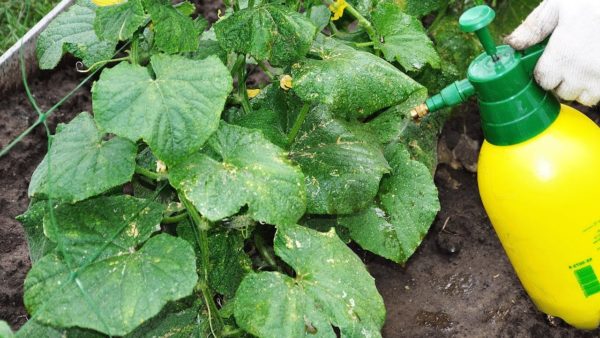
Shriveled leaves are often the result of improper feeding. Growth stimulants and fertilizers also need to be applied on time, otherwise it will harm the plants. During the growing cycle, cucumbers need different nutrients.Nitrogen helps to grow stems and the green part, potassium and calcium are responsible for the metabolism and preservation of water in the cells, and phosphorus is useful for fruits.
Before planting seedlings, cucumbers are soaked in a growth stimulator, after having been sanitized. For the first time, the sprouts are fed after the appearance of the second pair of leaves: nitrophoska, mullein infusion and potassium sulfate, as well as other nitrogen-based fertilizers, are suitable. Farther feed crops should be every 7-14 days, depending on the condition. If you notice that the leaves are curled, become dry and wrinkled - add food. At the first stages, you can safely apply chemistry, and closer to fruiting it is better to switch to folk methods. Even for the initial period, watering is well suited, and for the final - spraying.
Prevention
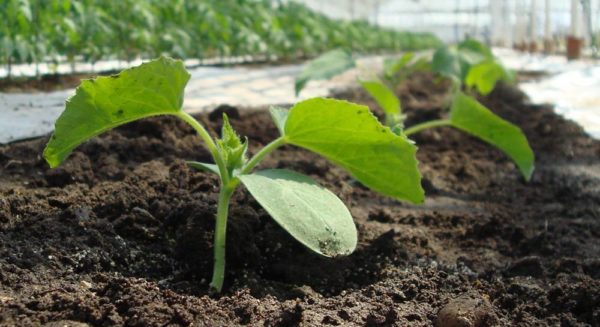
Most problems that cause leaf curl can be avoided. To do this, you must clearly follow the recommendations for a particular variety, withstand optimal humidity and temperature. Cucumbers love moisture, but its excess also harms them, so watering also needs to be regulated. Key tips to avoid twisted leaves:
- maintain an optimal climate in the greenhouse;
- observe crop rotation; one crop cannot be planted in one place for too long;
- regularly disinfect and disinfect the soil before sowing;
- grow seedlings in separate containers and transplant carefully;
- fill the deficit of minerals on time;
- loosen and moisten the soil, do not let it dry;
- process seeds before planting;
- remove from the soil the remnants of previous crops;
- Inspect plants regularly to check for irregularities.
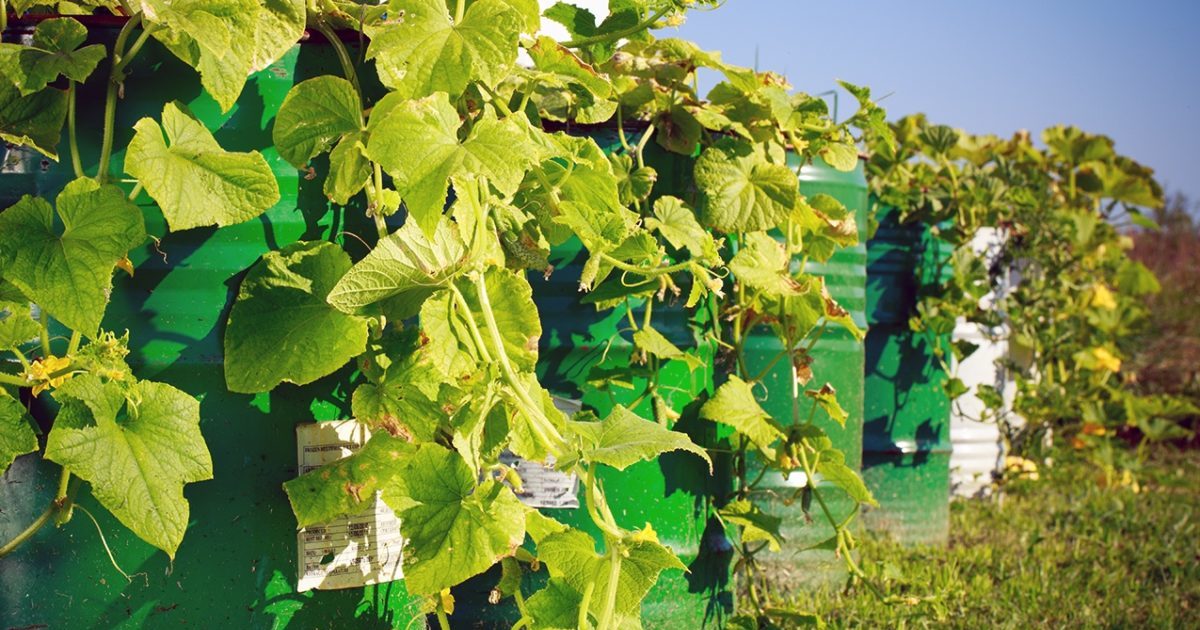 You may be interested in:
You may be interested in:It is important to respond on time if the leaves curl up or down, wrinkle and dry. This happens not only in open areas, but also in a greenhouse, and in cucumbers in seedlings on the windowsill. In most cases, the problem can be eliminated in the initial stages and not harm the crop. An important role is played by prevention. Proper care, timely, but not too plentiful watering, soil preparation, protection from direct best sunshine and fertilizing with fertilizers will help grow cucumbers beautiful and tasty.




 Armenian cucumber with melon flavor: description and characteristics, reviews
Armenian cucumber with melon flavor: description and characteristics, reviews Do-it-yourself vertical beds for cucumbers: schemes, photos
Do-it-yourself vertical beds for cucumbers: schemes, photos Hollow cucumbers: reasons for the appearance of hollow, what to do
Hollow cucumbers: reasons for the appearance of hollow, what to do Which manure is best for cucumbers: application, how to breed
Which manure is best for cucumbers: application, how to breed